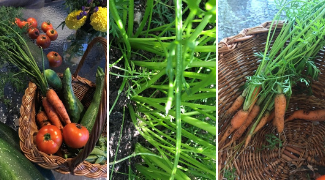 I have always been fascinated with growing things, mostly vegetables, occasionally flowers and houseplants. I have had varied success with the flowers and the houseplants, but, for the most part, I have had some spectacular yields from my home garden.
I have always been fascinated with growing things, mostly vegetables, occasionally flowers and houseplants. I have had varied success with the flowers and the houseplants, but, for the most part, I have had some spectacular yields from my home garden.
I can remember having a garden as far back as being in the second grade. I would help Mom and Dad, and always have a small patch that was “just mine”. When I went away to college and medical school, I would always “dig in” when I visited home and often would have a few potted plants I would reap rewards from come harvest time.
All growing plants need the basics, good soil, a little fertilizer or compost, adequate water and drainage, sunlight and time. That is all part of the science behind gardening. The art of gardening comes into play when we consider weeding and thinning. Weeds really aren’t that much of an issue once you identify the weeds. When plants are little, it is sometimes hard to distinguish the viable plant from a weed, especially if the weeds are the same size and are in alignment with your neatly planted rows, (or, if you are like my husband was and just “threw things in” not necessarily concerned with alignment). As the plants grow, it is easy to discern what are viable plants and what are the nuisance, damaging weeds that choke out your crops. Removing the weeds without interrupting the plants can sometimes take effort, but, emotionally, is very easy to do. Even the occasional weed that has a pretty or interesting bloom on it is still a weed and damaging to the crops. Seeing a garden free of weeds is rewarding to any home gardener.
What is more difficult for me is the idea of thinning out my plants. Particularly with root vegetables, it is important to thin out the plants once they start growing to ensure adequate room and nutrition so your choice plants can reach their full potential. Here is where my dilemma lies. How do I decide which plant to pull and discard? How do I feel when I pull a small plant and see a perfectly formed baby carrot, beet, radish? I actually am a little apprehensive and sad, knowing that the baby vegetable will not reach its potential, and get a little upset when I pull what I thought to be a tiny mutant and find a perfect specimen, more mature than I thought it would be. I realize, though, that if I do not thin my garden, none of my efforts will reach their potential. Oh, I will still have a harvest, but would it be the best harvest I could possibly reap? I do get some consolation that I can recycle these “little guys” in my compost bin. Some can actually be enjoyed as a snack. Every now and then if I pull what I consider a “keeper” I can transplant it elsewhere and allow it to continue to grow.
And so it is with all living creatures. There are the basics we all need - a place to grow, food, water, sunlight. It is important to discern and remove the weeds so one doesn’t get choked out and strangled. Sometimes it takes a little time to recognize what are weeds, but once identified, carefully removing the weeds with as little interruption to life as possible only allows more growth. Thinning things out takes a little more time, effort and contemplation, especially for the highly functioning, type A individual who is capable of doing so many things. Sure, trying to accomplish a multitude of things is possible, but when spread so thin, can one actually reach full potential in any given area?
So, how DO you grow? Are you ensuring you have the necessities to grow? What do you need to “weed out”? What life-choking, damaging things that may look pretty but rob you of the basic necessities you need to grow need to be pulled up and discarded? What do you need to “thin out” to make space for other parts of your life to reach fullest potential? Can you recycle what you are thinning out or transplant it elsewhere? Understanding that carefully tending your “garden” will allow you to enjoy a bountiful harvest, but it takes time, planning, thought and can get a little “dirty”.
